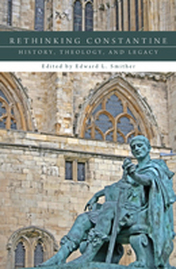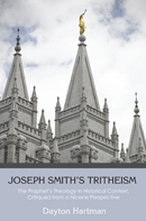posts
 I am happy to share that this new volume has now been released by Pickwick, an imprint of Wipf and Stock. The fruit of the 2012 Evangelical Theological Society's Patristic Study group session on Constantine, here is a short description from the publisher: What happens to the church when the emperor becomes a Christian? Seventeen hundred years after Constantine's victory at Milvian Bridge, scholars and students of history continue to debate the life and impact of the Roman emperor who converted to faith in the Christian God and gave peace to the church. This book joins that conversation and examines afresh the historical sources that inform our picture of Constantine, the theological developments that occurred in the wake of his rise to power, and aspects of Constantine's legacy that have shaped church history. I am thankful for each of the authors and the expertise that they have contributed to the book: Introduction (Edward L. Smither) 1- From Sinner to Saint? Seeking a Consistent Constantine (Glen L. Thompson) 2- Lactantius as Architect of a Constantinian and Christian "Victory over the Empire" (W. Brian Shelton) 3- Rethinking Constantine's Interaction with the North African "Donatist" Schism (David C. Alexander) 4- Reevaluating Constantine's Legacy in Trinitarian Orthodoxy: New Evidence from Eusebius of Caesarea's Commentary on Isaiah (Jonathan J. Armstrong) 5- Constantine, Sabbath-Keeping, and Sunday Observance (Paul A. Hartog) 6- Did the Rise of Constantine Mean the End of Christian Mission? (Edward L. Smither) Epilogue (Bryan M. Litfin) Finally, some early endorsements: "Like him or dislike him, one cannot ignore Constantine in Christianity. His legacy can be seen at every turn, from Sunday observance to law to ecclesiastical dress! These essays help us to come to terms with the scope of that legacy." —Thomas O'Loughlin, University of Nottingham "The early fourth-century Constantinian revolution had enormous consequences for the life and worship of the Christian Church—indeed, its far-reaching impact is still with us in a variety of ways. In recent days, both scholarly reassessment of this revolution and popular fiction have brought Constantine to public notice once again, and this collection of essays provides an extremely helpful guide in taking stock of one of the great turning points in church history." —Michael A.G. Haykin, The Southern Baptist Theological Seminary "If we are going to assess Constantinianism rightly, we have to get Constantine right. The contributors go a long way toward accomplishing this task. In place of the caricatured Constantine of popular fiction and theology, this collection of essays presents a living, breathing Constantine, flawed and failing, but a genuine believer struggling to use his power in a way that would please the 'Supreme God' who had chosen him." —Peter Leithart, New Saint Andrews College I was excited to see Switchfoot live in Charleston, SC this past weekend and they did not disappoint. They played at the Music Farm, a smaller venue that appears to have been some type of factory or mill in a previous life. While playing several songs from the new Fading West album, they also played a number from Vice Verses, Hello Hurricane, and some older classic songs (Dare You to Move, Gone, This is Your Life, Learning the Breathe). Though I couldn't stay for it, I heard that Jon Foreman went out on the street and played an acoustic after show. The band continues to demonstrate excellence at their craft as guitars, bass, drums, keys, and vocals melded together to produce a high quality modern rock show. A couple of things particularly stuck out:
First, was their presence, particularly that of frontman Jon Foreman. Jon acts like Bono in the body of Kurt Cobain. He was connected to the audience through his singing, brief words, and especially moving out into the crowd. He managed to make it up into both of the Music Farm's side lofts during the concert. Of course, he was even more personal with the acoustic after show. This connection was further aided because about half of Switchfoot's play list were quite singable--old songs with familiar lyrics but also new ones that caught on quick. Second, was their message. They sang songs like "This is the Sound"--dedicated to Christian activist John Perkins--that cried out for justice. Other songs like "This is Your Life" and "Love Alone is Worth the Fight" yearned for meaning and a truly satisfying life. By Jon Foreman's introduction, "Your Love is a Song" is about grace--and we would infer that this is about God's grace and forgiveness of sin given freely through Christ's sacrifice. Finally, the themes of justice and meaning were capped by songs of future hope--"Restless" and "World Where I Belong." Like their album Vice Verses, to me this concert had a strong eschatological element; that we yearn with a future hope for the day when God will bring about His justice, judgment, and right all that is wrong. Switchfoot, like U2, continues to raise important to life themes in their music--questions that are winsomely answered through the Gospel. My favorites for the night were "Love Alone is Worth the Fight," "Restless," and "Your Love is a Song." My wife bought me a t-shirt with the tour dates on the back and I hope one of them is near enough to catch the band again and perhaps stay for the after show. It's worth taking ten minutes to listen to the story of Olympic champion Scott Hamilton. I remember like it was yesterday watching him win gold in the men's figure skating at the 1984 Sarajevo Olympics. In recent Olympics, including the current Sochi games, he seemingly skates every program with the athletes through his passionate commentary.
I'm moved by Scott's faith story here for a few reasons. One was his perspective on being diagnosed with a brain tumor after his skating career; a tumor that had been with him all of his life that stunted his growth as a youth, which in turn probably helped him excel in the sport. Two, amid his ordeal with cancer and the tumor, others reached out to him and through their witness, he found Christ. Three, through physical pain and suffering, he has learned to pray and relate to God on a much deeper level. God has used suffering as a blessing in Scott Hamilton's journey and ultimately used physical pain and illness to lead to true and everlasting life in Christ. I'm really excited that U2 has some new music, including "Ordinary Love" that came out a few months ago as part of the soundtrack for the film "Mandela: Long Walk to Freedom." Last week, yet another single, "Invisible," was made free on iTunes and now the video has been released (have a listen).
"Invisible" is a pretty straight forward song that sounds like it could easily fit on a number of U2's past albums. Translation: they're still making good music. The activist rock band is also continuing to put out a challenging message. This song was recorded to bring awareness to the plight of AIDS victims in Africa and to raise money to save lives. With each free download, Bank of America made a donation to Red's Global Fund and to this point over $3 million has been raised. As Bono, with yearning voice, sings in the first person, we are invited for 4:12 to look at the world through the eyes of millions who suffer with AIDS: I’m more than you know I’m more than you see here I’m more than you let me be I’m more than you know A body in a soul You don’t see me but you will I am not invisible I am here As I listen to these lyrics, I realize that the invisible ones who suffer from AIDS (and probably also poverty and other forms of exploitation) still have dignity ("a body in a soul") because they are created in and bear the image of God. Discussing this reality, Andrew Louth (2012:87) helpfully notes, "we have been created by God the Father in the image of the Word [Jesus] through the Word." Despite having dignity, people with AIDS are also broken souls; yet they share their brokenness with the rest of humanity who are broken in different ways and by different things. There is no them, There’s only us There’s only you, And there’s only me U2 captures this solidarity through the words of this refrain and by delivering it in such a catchy and singable form. By song's end, the 1200 audience members in the video shoot are united in chorus. As I meditate on Scripture, I'm convinced that all of humanity bears the image of God and yet all of humanity stands condemned before God as sinners. The hope of the Gospel--the life, death, burial, and resurrection of Jesus--is that we can have a new start--new life--toward being fully restored to the image of God. Louth adds, "so that, through the Word [Jesus] who created us we might come to the knowledge of God the Father—this whole process takes place by grace, that is through the Spirit." Good song and good video. Now I'm waiting for the album and a chance to buy a ticket to see them live.  I was excited yesterday to see the announcement for this new book. Dayton Hartman was my student at Liberty University where I had the privilege to serve as mentor for his MA thesis--a presentation of the historic doctrine of the Trinity to Muslims. Dayton went on to earn his PhD in Church and Dogma History from North-West University in South Africa. Joseph Smith' Tritheism is the published version of that PhD thesis. Again, from a historic Nicene perspective, Dayton evaluates the theological claims of the founder of the Church of Jesus Christ of Latter Day Saints. The book description from the publisher's web site reads: Few figures in North American religious history are quite as enigmatic as Joseph Smith. His unabashed adherence to tritheism gave birth to one of the most influential religious movements in American history. Many attempts have been made to engage his life and unorthodox theology. However, Joseph Smith's Tritheism is a unique text that blends church history, thoughtful theological exegesis, and evangelical apologetics in an attempt to engage Joseph Smith's theology anew. Some early endorsers have written: Many books by evangelicals demonstrate the fundamental implausibility of Mormonism. Fewer books address carefully the theological positions advanced by the Latter Day Saints. Doing so can be a difficult task because Mormon theology frequently employs strategic ambiguity in order to accommodate contemporary sentiments. Dayton Hartman’s book falls into the second category. He approaches the topic of the Trinity in Joseph Smith’s teaching and how it has been restated over the history of the LDS Church. But first, he demonstrates how orthodox Trinitarianism is rooted in the Bible and how the early church arrived at its definitive declarations. Then he points out the historical factors that may have led to Joseph Smith’s unorthodox point of view, the change it underwent over his lifetime, and the further revisions introduced by subsequent LDS thinkers. In contrast to many works in apologetics, this book does not leave the reader hanging with merely a negative critique but also provides a careful explication of the orthodox view. It is helpful both for its content and for the method that Hartman exemplifies as a blue print for others to follow. Winfried Corduan, Ph.D. Professor Emeritus of Philosophy and Religion, Taylor University Author of Neighboring Faiths Dayton Hartman’s well-researched and well-reasoned book serves as a reminder that a proper understanding of the Christian doctrine of the Trinity—in its biblical and historical context—is necessary to accurately evaluate the theological claims of Mormonism, not to mention other departures from orthodoxy. Hartman ably shows that Mormonism’s view of deity is deficient and that creedal Christianity, which is a truthful distillation of the Scriptures, is not. Paul Copan, Ph.D. Pledger Family Chair of Philosophy and Ethics, Palm Beach Atlantic University Author of Is God a Moral Monster? Congratulations Dayton! |
Archives
November 2023
|

 RSS Feed
RSS Feed
